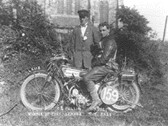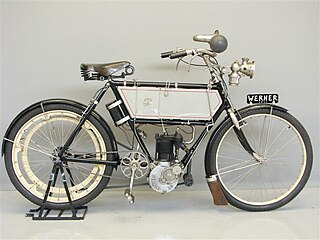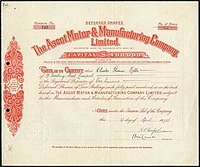
Vespa is an Italian brand of scooter manufactured by Piaggio. The name means wasp in Italian. The Vespa has evolved from a single model motor scooter manufactured in 1946 by Piaggio & Co. S.p.A. of Pontedera, Italy to a full line of scooters and one of seven companies today owned by Piaggio.

A flat-twin engine is a two-cylinder internal combustion engine with the cylinders on opposite sides of the crankshaft. The most common type of flat-twin engine is the boxer-twin engine, where both cylinders move inwards and outwards at the same time.

The Norton Motorcycle Company is a brand of motorcycles, originally based in Birmingham, England. For some years around 1990, the rights to use the name on motorcycles was owned by North American financiers. Later, a line of motorcycles was produced under Chief Executive Stuart Garner. Due to financial failure with large debts, in April 2020 administrators BDO agreed to sell certain aspects of Garner's business to Project 303 Bidco Limited, a new business established for the purpose with links to Indian motorcycle producer TVS Motor Company.

Velocette is a line of motorcycles made by Veloce Ltd, in Hall Green, Birmingham, England. One of several motorcycle manufacturers in Birmingham, Velocette was a small, family-owned firm, selling almost as many hand-built motorcycles during its lifetime, as the mass-produced machines of the giant BSA and Norton concerns. Renowned for the quality of its products, the company was "always in the picture" in international motorcycle racing, from the mid-1920s through the 1950s, culminating in two World Championship titles and its legendary and still-unbeaten 24 hours at over 100 mph (161 km/h) record. Veloce, while small, was a great technical innovator and many of its patented designs are commonplace on motorcycles today, including the positive-stop foot shift and swinging arm rear suspension with hydraulic dampers. The business suffered a gradual commercial decline during the late 1960s, eventually closing in February 1971.

L'Aster, Aster, Ateliers de Construction Mecanique l'Aster, was a French manufacturer of automobiles and the leading supplier of engines to other manufacturers from the late 1890s until circa 1910/12. Although primarily known as an engine mass manufacturer the company also produced chassis for coach-works and a complete range of components.
Royal Enfield was a brand name under which The Enfield Cycle Company Limited of Redditch, Worcestershire sold motorcycles, bicycles, lawnmowers and stationary engines which they had manufactured. Enfield Cycle Company also used the brand name Enfield without Royal.

Vincent Motorcycles was a British manufacturer of motorcycles from 1928 to 1955. The business was established by Philip Vincent who bought an existing manufacturing name HRD, initially renaming it as Vincent HRD, producing his own motorcycles as HRD did previously with engines purchased as complete assemblies from other companies. From 1934, two new engines were developed as single cylinder in 500 cc and v-twin 1,000 cc capacities. Production grew from 1936, with the most-famous models being developed from the original designs after the War period in the late 1940s.

Motor Rail was a British locomotive-building company, originally based in Lewes, Sussex, they moved in 1916 to Bedford. In 1987 loco manufacture ceased, and the business line sold to Alan Keef Ltd of Ross-on-Wye, who continue to provide spares and have built several locomotives to Motor Rail designs.

Cyril Pullin was a British inventor, engineer and motorcycle race driver. His inventions contributed to the rotary engine and the helicopter. His son was the pilot for the first successful British helicopter flight in 1938. Cyril Pullin died in 1973 aged 80.

The Ner-A-Car was a type of feet forwards motorcycle designed by Carl Neracher in 1918. It used an unusual steel-channel chassis, much like an automobile, and hub-center steering at the front wheel, making it 'nearly a car' in design. The Ner-A-Car was the most successful hub-center steering motorcycle ever produced, with sales far eclipsing earlier or later examples of this design, such as the Yamaha GTS1000 or Bimota Tesi. About 10,000 Neracars were manufactured in the United States by the Ner-A-Car Corporation, while around 6,500 are believed to have been produced in England under licence by the Sheffield-Simplex company between 1921 and 1926 under the Ner-A-Car name.

Ariel Motorcycles was a British maker of bicycles and then motorcycles in Bournbrook, Birmingham. It was an innovator in British motorcycling, part of the Ariel marque. The company was sold to BSA in 1951 but the brand survived until 1967. Influential Ariel designers included Val Page and Edward Turner. The last motorcycle-type vehicle to carry the Ariel name was a short-lived three-wheel tilting moped in 1970.
The Garrard & Blumfield or Blumfield & Garrard was an English electric car manufacturer from 1894 to 1896. The company is presumed to have been founded by C. R. Garrard and T. W. Blumfield.

Douglas was a British motorcycle manufacturer from 1907–1957 based in Kingswood, Bristol, owned by the Douglas family, and especially known for its horizontally opposed twin cylinder engined bikes and as manufacturers of speedway machines. The company also built a range of cars between 1913 and 1922.

ABC motorcycles was a British motorcycle manufacturer established in 1914 by Ronald Charteris in London. Several British motorcycle firms started up with the name "ABC", including Sopwith. The All British Engine Company Ltd. of London was founded in 1912 and later changed to ABC Motors Ltd. With chief engineer Granville Bradshaw, Charteris built a range of engines throughout the First World War. From 1913 ABC produced motorcycle engines.
Alfred Angas Scott (1875–1923) was a British motorcycle designer, inventor and founder of the Scott Motorcycle Company. A prolific inventor, he took out over 50 patents between 1897 and 1920, mostly concerning two-stroke engines and road vehicles. Scott was a keen potholer and the second president of the Gritstone club. In July 1923 Scott travelled back to Bradford in his open Scott Sociable wearing wet potholing clothes and contracted pneumonia from which he died.

The Ascot-Pullin 500 was a motorcycle made by Ascot-Pullin Motorcycles in Letchworth, Hertfordshire in 1928. As an updated version of the Pullin motor bicycle of 1919, the Ascot-Pullin 500 overhead valve single was the first time hydraulic brakes were used on a motorcycle.

The Bat Motor Manufacturing Co. Ltd was a British motorcycle manufacturer that operated between 1902 and 1926. Significant innovations developed by the company included one of the first motorcycle suspension systems, with a leading link front fork and a subframe suspended on springs from the main frame.
Quadrant was one of the earliest British motorcycle manufacturers, established in Birmingham in 1901. Famous for their big singles, Quadrant pioneered many innovations that proved important for motorcycle development but struggled after the First World War and the company was wound up in 1928.

The Werner Brothers, Michel and Eugene, were of French nationality but were originally from Russia. They started to experiment with motorized bicycles in 1896 and are credited with the first use of the word "Motocyclette" in 1897.

The Acme Motor Co is a defunct manufacturer of motorcycles that operated from premises in Earlsdon, Coventry. The company started manufacturing in 1902. It was taken over by Rex motorcycles sometime before 1920. In 1922 the name of the company was changed to Coventry Acme Motor Co, later that year the company was merged with Rex motorcycles to form Rex-Acme.

















